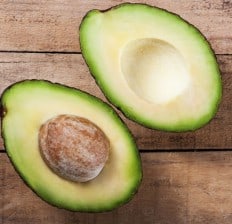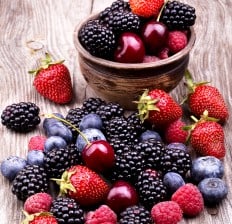Copper
is a trace mineral, meaning it is needed in a very small quantity. Its primary role is to help form hemoglobin and collagen in the body.
A deficiency in copper results in poorly formed red blood cells, known as anemia. It also is an antioxidant, helping with the elimination of free radicals.
Copper deficiency symptoms can include increased parasitic infections, weakness from anemia and leaky gut.
Copper must stay in balance with zinc and iron in the body as well and if you consume too much of one it can throw the others out of balance.
The RDA for copper is 900 mcg/day. The Daily Value is 2 mg.

Zinc Aids in Digestion
Zinc affects protein synthesis and is required by the body to use amino acids from foods. It’s also involved in the breakdown of carbohydrates from foods, which are one of the main sources of energy for the body. For this reason, deficiency in zinc can cause low energy levels and contribute to adrenal or chronic fatigue, whereas consuming enough zinc benefits ongoing energy and a healthy metabolism.
Supports Liver Health
Supplementing with zinc is shown to reduce the incidence of infection and correlated with lower levels of liver damage. Zinc can help with a liver cleanseto reduce inflammation in the liver, reduces free radical damage, helps with nutrient absorption and allows for proper waste elimination.
Muscle Growth and Repair
Zinc plays a crucial role in cell division and cell growth, so zinc benefits muscle repairment and growth by making it possible for the body to heal itself and maintain strength in the muscular and skeletal systems. Zinc also helps with the release of testosterone, growth hormone and insulin-like growth factor-1 (IGF-1), all of which build muscle mass and a healthy metabolism.

Magnesium Rich Foods
Women RDA 310 milg a day
- Spinach — 1 cup 40%
- Dark Chocolate — 1 square 24%
- Avocado — 1 med 15%
- Pumpkin seeds — 1/8 cup 23%
- Almonds — 1 ounce 20%
- Yogurt or Kefir — 1 cup 13%
- Banana — 1 med 8%
Other foods that are also high in magnesium include: salmon, coriander, cashews, goat cheese and artichokes.


Important Sources Of Potassium
A balanced diet must contain a fair quantity of potassium, as per the recommendations of health experts. The most important dietary sources are citrus fruits, vegetables, and grains. Also, you can get an ample amount of potassium from salmon, chicken, whole milk, fresh fruit juices, and almonds. Apart from those, nuts, lime beans, potatoes, and poultry are other products to be included in the potassium boosting list. However, the most important sources of potassium are avocados, bananas, and coconut water.

Prevents Muscle Spasms and Pain
By balancing fluid levels, potassium helps the muscles to relax, so low potassium can result in muscle spasms, cramps and general pains. Because of how it’s used to help breakdown carbs and proteins that muscles rely on for energy and repair, low potassium can also cause a breakdown of muscle mass, fatigue, trouble exercising and can even possibly contribute to weight gain.
Potassium
Deficiency of any nutrient in the body is undesirable and potassium is not an exception. A diet deficient in it may lead to symptoms like fatigue and muscle weakness, anemia and severe headaches.
Potassium-deficient people may also experience high blood pressure, pain in their intestines, swelling in their glands and diabetes as serious side effects of this deficiency.
Needed for Proper Digestion
Potassium acts like an electrolyte, helping to balance water, fluid and sodium levels within the digestive tract. Low potassium can contribute to bloating, constipation or abdominal pain in some cases because fluids build up and cause imbalances in minerals.
It’s also partially responsible for balancing the amount of acid in the stomach, healing the gut and keeping the body at the optimal pH level. This allows healthy bacteria to thrive and kill off harmful bacteria that lower immunity.
Wheatgrass
is a source of potassium, dietary fiber, vitamin A, vitamin C, vitamin E (alpha tocopherol), vitamin K, thiamin, riboflavin, niacin, vitamin B6, pantothenic acid, iron, zinc, copper, manganese and selenium.
Wheatgrass is also a source of protein.
is a source of potassium, dietary fiber, vitamin A, vitamin C, vitamin E (alpha tocopherol), vitamin K, thiamin, riboflavin, niacin, vitamin B6, pantothenic acid, iron, zinc, copper, manganese and selenium.
Wheatgrass is also a source of protein.
HIGH FIBER FOODS
Recommended Daily Fiber:
Women 25 grams
Men 35-40 grams

1. Avocados
Total Dietary Fiber: 10.5 grams per cup (sliced)
Notable Nutrients: Vitamin C, Vitamin E, Vitamin B6, Folate, Vitamin K, Potassium
The fiber content of avocados varies depending on the type. There is a difference in fiber content and makeup between the between the bright green, smooth skinned avocados (Florida avocados) and the smaller darker and dimpled variety (California avocados). Florida avocados have significantly more insoluble fiber than California avocados. In addition to the fiber, avocados are packed with healthy fats that help to lower cholesterol and reduce the risk of heart disease. Start incorporating fresh avocado into your diet with some of these avocado recipes.


2. Asian Pears
Total Dietary Fiber: 9.9 grams of fiber per medium fruit, skin on.
Notable Nutrients: Vitamin C, Vitamin K, Omega 6 fatty acids, Potassium
Crisp, sweet, and delicious, Asian Pears contain high levels of fiber, but also is rich in Omega-6 fatty acids (149 mg per serving) associated with healthy cells, brain and nerve function.(1) The American Heart Association recommends at least 5%-10% of food calories come from Omega 6 fatty acid foods.

